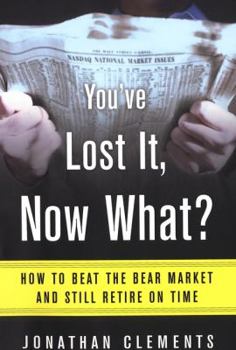You've Lost It, Now What?: How to Beat the Bear Market and Still Retire on Time
Even if you have lost 40, 50, or even 80 percent of your savings, it is still possible to retire in comfort. This year's stock market collapse has been especially devastating to millions of Americans... This description may be from another edition of this product.
Format:Hardcover
Language:English
ISBN:1591840163
ISBN13:9781591840169
Release Date:March 2003
Publisher:Portfolio
Length:208 Pages
Weight:0.90 lbs.
Dimensions:0.9" x 5.8" x 8.6"
Customer Reviews
4 ratings
"Bully" for this book
Published by Thriftbooks.com User , 16 years ago
A fantastic, easy to understand overview of the road to and through retirement in a thoroughly entertaining format. Clements' work here mirrors his enjoyable columns found in The Wall Street Journal.
Good Start
Published by Thriftbooks.com User , 18 years ago
I read this book because I like the column Mr. Clements writes for the Wall St Journal. I felt that even years after the recent market collapse, it would be a guide for the future even if I didn't lose it all. The book didn't disappoint.This book is a help getting the necessary insight to the individual investor like me. It get's a little complicated and detailed in places but the basics are here: saving, indexing, rebalancing, retiring. There is also insight - if you worry about your portfolio before retiring, it's worse when it's your main source of income. As Mr. Clements advises, you must learn some basics to be successful at investing.The "experts" you may hire have other agendas.
Read a common sense guide to investing
Published by Thriftbooks.com User , 21 years ago
As a CPA and registered investment adviser, I am always looking for a way to explain investment principles to my clients in a way they can easily understand. This book accomplishes this all-important function, and is a must read for investors. Jonathan presents common sense information which is unbiased. Many investors would profit from following the guidelines Jonathan presents, and should.Jonathan presents a realistic approach to investing that avoids the day to day stimuli that can lead investors astray. The book also provides hope to those who've truly "lost it", either in dollar terms or in terms of their approach to investing.People who read and understand this book will be ahead of those who don't, whether they invest on their own or use an adviser. I know anyone who has read this book will be better educated and will better understand investing.
Rx for Bear Market Paralysis
Published by Thriftbooks.com User , 21 years ago
Investors contemplating retirement, but stunned by losses sustained in the extended bear market that began in the spring of 2000, will find hope and encouragement in Wall Street Journal columnist Jonathan Clements' "Now What?". This is a do-it-for-yourself repair strategy for baby boomers with badly damaged bubble portfolios. First, face facts, we are told: You've got a "bone-head" portfolio, and it's not likely to come back in value, so sell your losers. Forget the "foolish beat-the-market fantasy" promoted by Wall Street's brokerage houses and money management firms. Invest to capture market returns with stock index funds. Diversify with stocks, bonds, and real estate. Specifically, you should own large and small US stocks and foreign stocks. For the bond portion of your portfolio, use inflation indexed treasuries and short-term corporate funds, and to boost your income, consider high yield bond mutual funds. Clements recognizes that "this will be the decade of the dividend and interest payment". So, REITS (real estate income trusts) with their high, single-digit returns, should represent 10-15% of your portfolio. In all this, Jonathan Clements is in good company: W. Bernstein, C. Ellis, B. Malkiel, L.Swedroe, B. Schultheis, et.al., have recently written (or updated) books with similar conclusions. Clements' contribution is in the timeliness of his insistence that boomers can salvage their own retirement plans by acting to keep investment costs in check, diversifying, and saving "like crazy". Indeed, the investment process should be simple to follow. "Why are we such sluts for sophistication?" Clements asks with exasperation. Readers may be skeptical that a fifty-year old, in an example, who hasn't saved a "nickel" for retirement can accomplish much by age sixty-five. But this late starting investor is not the book's primary focus. 'Gilding the Golden Years' (Chapter 7) is one of the author's better chapters. Investing may be "simple", but it is also an art, so this frequently quoted columnist's portfolio advice is of value. Clements is clearly intrigued by a strategy of establishing multiple sources of investment income during retirement. In addition to income from social security, 401k-style plans, pensions, and humbled securities portfolios, investors might consider an immediate annuity, a reverse mortgage, or even part-time work. After all, if it's true that investors should take no more than five percent of their investment assets each year for income, working part-time to earn five thousand dollars is like having another hundred thousand dollars in retirment assets. And an unconventional idea like a reverse mortgage may take on a new practicality for today's generation of soon-to-be retired. Investors paralyzed by their recent bear market experience will find sound, helpful advice in this book.





